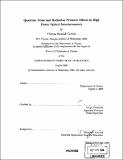Quantum noise and radiation pressure effects in high power optical interferometers
Author(s)
Corbitt, Thomas Randall
DownloadFull printable version (51.24Mb)
Other Contributors
Massachusetts Institute of Technology. Dept. of Physics.
Advisor
Nergis Mavalvala.
Terms of use
Metadata
Show full item recordAbstract
In recent years, a variety of mechanical systems have been approaching quantum limits to their sensitivity of continuous position measurements imposed by the Heisenberg Uncertainty Principle. Most notably, gravitational wave interferometers, such as the Laser Interferometer Gravitational wave Observatory (LIGO), operate within a factor of 10 of the standard quantum limit. Here we characterize and manipulate quantum noise in a variety of alternative topologies which may lead to higher sensitivity GW detectors, and also provide an excellent testbed for fundamental quantum mechanics. Techniques considered include injection and generation of non-classical (squeezed) states of light, and cooling and trapping of macroscopic mirror degrees of freedom by manipulation of the optomechanical coupling between radiation pressure and mirror motion. A computational tool is developed to model complex optomechanical systems in which these effects arise. The simulation tool is used to design an apparatus capable of demonstrating a variety of radiation pressure effects, most notably ponderomotive squeezing and the optical spring effect. A series of experiments were performed, designed to approach measurement of these effects. The experiments use a 1 gram mirror to show progressively stronger radiation pressure effects, but only in the classical regime. The most significant result of these experiments is that we use radiation pressure from two" optical fields to shift the mechanical resonant frequency of a suspended mirror from 172 Hz to 1.8 kHz, while simultaneously damping its motion. The technique could prove useful in advanced gravitational wave interferometers by easing control issues, and also has the side effect of effectively cooling the mirror by removing its thermal energy. We show that with improvements, the technique may allow the quantum ground state of the mirror to be approached. Finally, we discuss future prospects for approaching quantum effects in the experiments.
Description
Thesis (Ph. D.)--Massachusetts Institute of Technology, Dept. of Physics, 2008. Includes bibliographical references (p. 181-189).
Date issued
2008Department
Massachusetts Institute of Technology. Department of PhysicsPublisher
Massachusetts Institute of Technology
Keywords
Physics.